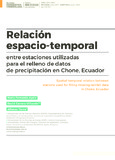Relación espacio-temporal entre estaciones utilizadas para el relleno de datos de precipitación en Chone, Ecuador

View/
Date
2018Palabras Clave
Regresión lineal, Test de rachas, Representatividad, Datos ausentesLinear regression, Run test, Representativity, Missing data
Metadata
Show full item recordAbstract
En el presente estudio se aplica la metodología de regresión lineal para completar los datos faltantes de los registros de precipitación de la estación climatológica principal de Chone, a partir de la información de seis estaciones cercanas con una temporalidad similar a la estación de interés. Los datos obtenidos fueron validados mediante un test de rachas y el método de curva de doble masa. El objetivo del trabajo fue encontrar un grado de relación entre las distancias de las estaciones auxiliares a la estación de Chone (d) y los promedios de los coeficientes de correlación (r) de las estaciones auxiliares, obtenidos en el proceso de relleno de datos faltantes. Se obtuvieron así coeficientes de correlación (r) con valores superiores a 0,5 representando correlaciones positivas moderadas
e intensas. Finalmente, se determinó que las variables d y r están linealmente relacionadas en un sentido inverso.
Collections
Información Adicional
| Otros Títulos | Spatial-temporal relation between stations used for filling missing rainfall data in Chone, Ecuador |
| Correo Electrónico | mfayala@espe.edu.ec |
| Editor | Saber-ULA |
| ISSN | 1012-1617 |
| ISSN Electrónico | 2244-8853 |
| Resumen en otro Idioma | In this study, the methodology of linear regression was used to complete the missing rainfall records of the Chone main climatological station from the information of six nearby stations with a similar temporality with the station of interest. The obtained data were validated by a run test and the double mass curve method. The objective of this study was to find a degree of relationship between the distances of the auxiliary stations to the Chone station (d) and the averages of the correlation coefficients (r) of the auxiliary stations obtained in the process of filling the missing data. Correlation coefficients (r) were obtained with values higher than 0.5, representing moderate and intense positive correlations. Finally, it was determined that the variables d and r were linearly related in inverse sense. |
| Colación | 298-313 |
| Periodicidad | Semestral |
| País | Venezuela |
| Institución | Universidad de Los Andes |
| Publicación Electrónica | Revista Geográfica Venezolana |
| Sección | Revista Geografica Venezolana: Artículos |





